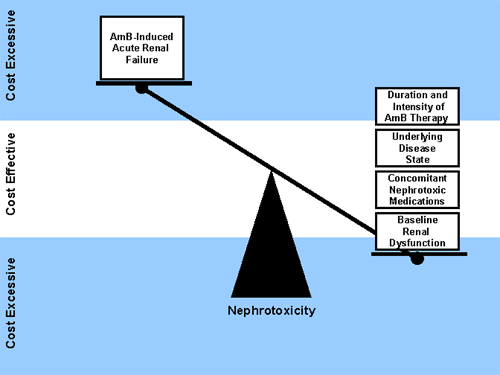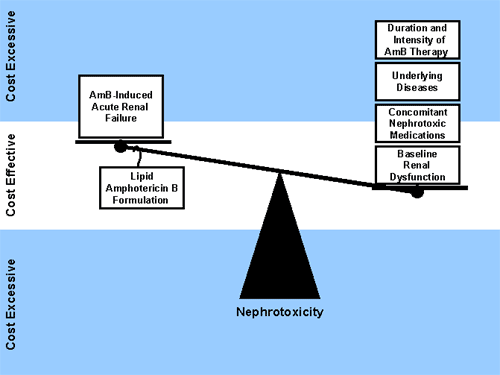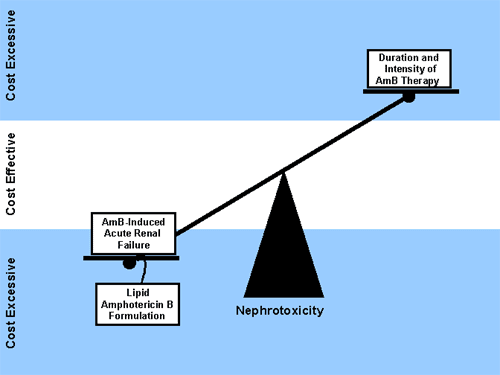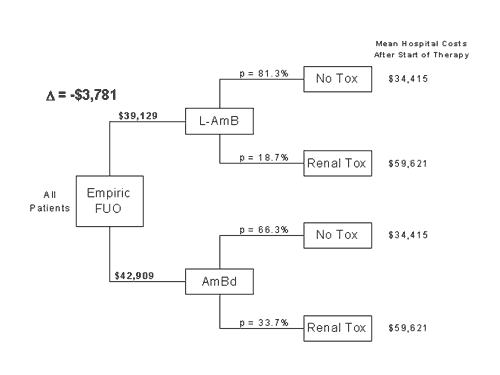All drugs have two costs. In addition to their acquisition costs, cost of monitoring and treatment of side effects must also be considered. These secondary costs are especially important with antifungal agents. Invasive fungal infections are often difficult to diagnose, resistant to treatment, and associated with high rates of morbidity and mortality [1980]. It is not surprising, then, that invasive fungal infections are also one of the most expensive complications that can be encountered in hospitalized patients. Until recently, studies examining the pharmacoeconomics of antifungal therapy were a low priority, as few antifungal therapies were available and costs related to antifungal acquisition and administration appeared (at least by ICD-9 billing) to be a small portion of overall expenditures [1894] (Figure 1).
Figure 1. Overall average cost of candidemia in 1993 determined from ICD-9 Billing Code (U.S. 1997 $)

Interest in the pharmacoeconomics of antifungal therapy has grown, however, with the introduction of several lipid formulations of amphotericin B (LFAB). The LFAB were a major advance over conventional amphotericin B deoxycholate (AmBd), as these formulations appeared to have equivalent efficacy to AmBd, but with reduced nephrotoxicity. If it were not for the 10 to 50-fold higher acquisition cost of LFAB, their first-line use would be widely adopted [1913]. Thus, the arrival of these agents onto the market (and more recently the echinocandins) has forced institutions to more closely examine secondary costs associated with antifungal therapy. For AmBd, the most important secondary costs arise from resources utilized in the management of nephrotoxicity [2443, 2481].
What is the price of nephrotoxicity?
The severity and reversibility of AmBd nephrotoxicity often depends on the number of pre-existing risk factors a patient already has for developing renal dysfunction [1385]. The most common factors that have been identified in retrospective studies of AmB-nephrotoxicity include: 1) Baseline renal dysfunction, 2) Previous or concurrent administration of nephrotoxic agents (i.e. cyclosporin, aminoglycosides), 3) Prolonged therapy with high dosages of AmBd (i.e. treatment for invasive aspergillosis), 4) Underlying disease state associated with renal dysfunction (i.e. diabetes, sepsis).
In patients with numerous risk factors for developing renal dysfunction, nephrotoxicity may be irreversible and contribute to poorer clinical outcome. Moreover, nephrotoxicity can have a dramatic impact on secondary costs incurred with antifungal therapy. Restricting the use of an antifungal such as LFAB that may slow or prevent the development of significant renal dysfunction, may result in higher secondary costs and excessive patient morbidity if the patient progresses to dialysis or has an increased length of stay in hospital (Figure 2A) .
Figure 2A. Schematic Representation of the Balance Between Amphotericin B-Induced Nephrotoxicity, Patient Risk Factors, and Cost Effective Therapy

By utilizing a more expensive but less nephrotoxic agent first line (such as LFAB), it is possible that some patients will not progress to nephrotoxicity requiring substantial outlay of hospital resources for management. Thus secondary costs may be minimized, making the antifungal therapy more cost effective overall (Figure 2B).
Figure 2B. Cost-Effective Balancing Effect of First Line Use of LFAB (or Echinocandins)

Conversely, many patients have few risk factors for developing AmBd-associated nephrotoxicity. If nephrotoxicity develops, it is generally reversible and managed with minimal resources at a limited secondary cost. First line use of a LFAB in this situation can be cost excessive in these low-risk patients (Figure 2C).
Figure 2C. Cost-Excessive Unbalancing Effect of First Line Use of LFAB (or Echinocandins) in Patients at Low Risk for Renal Dysfunction.

Thus, an important goal in determining the cost effectiveness of antifungal therapy is finding a balance between primary (acquisition) and secondary costs.
Interestingly, this “break even” point was recently the focus of a pharmacoeconomic analysis of a recent National Institute of Allergy and Infectious Diseases Mycoses Study Group trial, which compared a 3 mg/kg dose of liposomal amphotericin B (AmBisome) with 0.6 mg/kg of AmBd as empirical therapy in persistently febrile neutropenic patients [359, 2357]. Itemized, electronic billing data were collected on 414 patients from 19 of the 32 centers that participated in the trial.
Hospital costs were significantly higher for all patients who received the liposomal formulation of amphotericin B, however this difference was mostly driven by the cost of study medication. If the acquisition cost of the antifungals was not included in the analysis, (secondary) costs were lower in patients receiving the liposomal formulation of amphotericin B (Figure 3A)
Figure 3A. Decision analysis model for all patients receiving Liposomal AmB (L-AmB) vs. Amphotericin B Deoxycolate (AmBd). Adapted from [359].

Secondary cost savings were even higher among high risk patients (allogeneic bone marrow transplant recipients). In this group, the difference in secondary costs was ~ $5,500 (Figure 3B). The higher rate of nephrotoxicity among patients receiving AmBd resulted in higher hospitalization costs, mostly from increased hospital length of stay and increased utilization of pharmacy and blood bank resources.
Figure 3B. Decision analysis model for allogeneic BMT patients receiving Liposomal AmB (L-AmB) vs. Amphotericin B Deoxycolate (AmBd). Adapted from [359].

The authors used these sensitivity analyses to estimate an acquisition cost of L-AmB that would counterbalance increased secondary costs associated with AmBd nephrotoxicity. Once the cost of L-AmB was no higher than $85 per 50 mg, or $340 for a 3 mg/kg dose for a 70 kg adult, overall cost of antifungal therapy was the same for L-AmB as AmBd. Among higher risk allogeneic BMT patients, the breakeven cost climbed to $112 per 50 mg vial (or $470 mg/day for 70 kg adult).
In conclusion, this study illustrates two key points that need to be considered when examining the pharmacoeconomics of antifungal therapy: 1) Both primary and secondary costs are crucial towards determining the overall cost of antifungal therapy. 2) The sicker the patient, the greater the importance of secondary costs.
